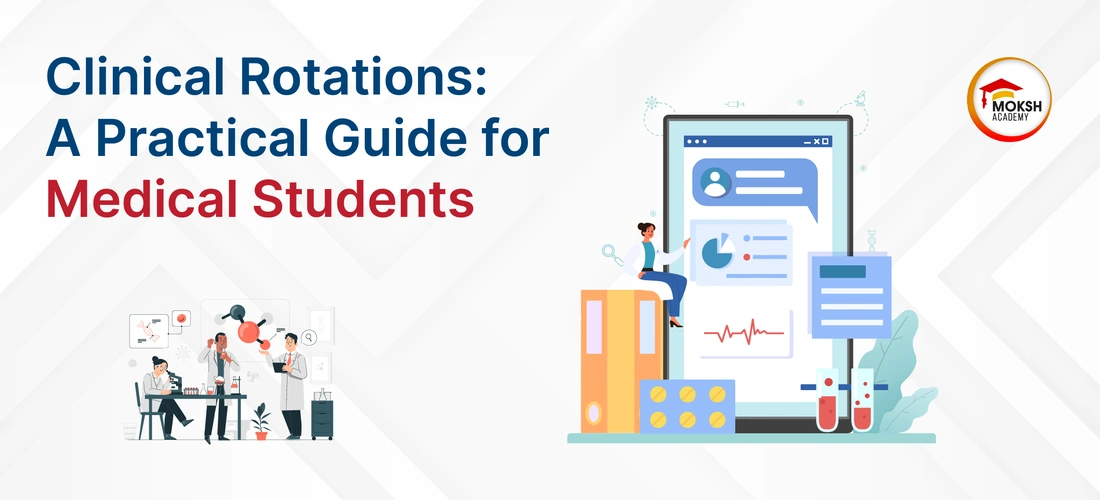
What are Clinical Rotations
Clinical rotations are a practical opportunity to apply your knowledge of clinical subjects to real-world patient care and to develop the skills to diagnose and treat patients.
Clinical Rotations for International Medical Graduates
As an International Medical Graduate (IMG), clinical rotations (clerkships) are essential to your success in matching into a residency program in the United States. Clinical clerkships for IMG will allow me to gain hands-on experience in the U.S. healthcare system, work with American physicians, and obtain letters of recommendation.
Here are some of the advantages of clinical rotations for IMGs
- Hands-on experience: IMG clinical rotations allow you to use your knowledge and skills in a real-world medical setting. You will learn from experienced physicians and be able to practice your clinical skills on actual patients.
- Letters of recommendation: A recommendation from an American physician is essential for matching into a residency program. Clinical rotations allow you to build relationships with physicians who can provide strong letters of recommendation.
- Performance evaluations: IMG Clinical rotations provide you with feedback on your performance from experienced physicians. This feedback can help identify your strengths and weaknesses and develop an improvement plan.
- Pathway to residency: Clinical rotations are a pathway to residency for IMGs. Many residency programs require IMGs to have U.S. clinical experience. By completing clinical rotations, you can demonstrate to residency programs that you have the skills and knowledge necessary to be a successful resident.
The outlook for IMGs in the United States is positive. There is a shortage of physicians in the U.S., and many residency programs are looking to IMGs to fill this shortage. By completing International clinical rotations, you can increase your chances of matching into a residency program and becoming a successful physician in the United States.
Benefits of Clinical Rotations:
Here are some of the specific benefits of clinical rotations:
- Exposure to a variety of patients and conditions. Clinical rotations allow medical students to see patients with different diseases and conditions. This exposure helps students to develop a broad knowledge of medicine and to learn how to manage a variety of patient presentations.

- Development of clinical skills. Clinical rotations are supervised hands-on training opportunities to practice and develop clinical skills. It includes history taking, physical examination, diagnosis, and treatment.
- They improved communication and teamwork skills. Clinical rotations require medical students to work closely with other medical specialists, including doctors, nurses, and pharmacists. Students gain teamwork and communication skills from this experience, essential for success in the healthcare industry.
- Understanding of the healthcare system. Clinical rotations give medical students a first-hand look at how the healthcare system works. It includes understanding the different roles of healthcare professionals and the challenges and opportunities facing the healthcare system.
- Preparation for residency. Clinical rotations are an essential part of preparing for residency. Residency programs place a high value on clinical experience, and students with strong clinical skills are more likely to be accepted into their preferred residency programs.
Types of Clinical Rotations in the U.S.
Clinical rotations are supervised training experiences that medical students and residents complete in different medical specialties. Clinical rotations occur after the basic science or medical curriculum and can be grouped into two broad categories: core and elective.
Core Clinical rotations are mandatory rotations that students are required to complete to graduate. Typical core clinical rotations include:
- Family medicine
- Internal medicine
- Neurology
- Obstetrics and gynecology
- Paediatrics
- Psychiatry
- General surgery
Elective rotations, offered during internships, are optional clinical experiences chosen by students based on their interests. Clerkships, on the other hand, are required clinical rotations undertaken after graduation
Hands-on rotations are the most common type of clinical rotation. In a hands-on rotation, students work directly with patients, performing physical exams, ordering and interpreting tests, and developing and implementing treatment plans.
Observerships are clinical rotations where students observe experienced physicians and other healthcare professionals. Observerships are an excellent way for students to learn about different specialties and develop clinical skills in a low-pressure environment.
Virtual rotations are online clinical rotations students complete remotely, by video conferencing and other online tools. Virtual Clinical rotations have become more prevalent in recent years as they allow students to gain clinical experience from anywhere in the world.
Telerotation is a virtual rotation type in which students work with patients remotely, using video conferencing and other online tools. Telemedicine rotations are a good way for students to gain clinical experience with patients who live in rural or underserved areas.
Which type of clinical rotation is right for you depends on your needs and goals. If you are still deciding which rotation type to choose, talk to your academic advisor or a trusted mentor.
Duration of clinical rotations
The length of clinical rotations varies depending on the medical school and the hospital. Some rotations may be as short as two weeks, while others may last up to eight weeks. The average duration of some standard clinical rotations is as follows:
| Medical Program |
Duration |
| Anesthesiology |
Four weeks |
| Emergency Medicine |
Eight weeks |
| Family Medicine |
Eight weeks |
| General Surgery |
Eight weeks |
| Internal Medicine |
Eight weeks |
| Neurology |
Eight weeks |
| Obstetrics and Gynecology |
Six weeks |
| Pathology |
Six weeks |
| Paediatrics |
Six weeks |
| Physical Medicine and Rehabilitation (PM&R) |
Four weeks |
| Psychiatry |
Six weeks |
| Radiology |
Six weeks |
The duration of a clinical rotation for medical students may also depend on the hospital's specialty and strength. For example, a clinical course in emergency medicine at a large metropolitan hospital may be longer than a rotation at a smaller rural hospital.
Here are some factors that may affect the duration of a clinical rotation:
- Medical school curriculum: Some medical schools have stricter curriculum requirements than others, which may affect the course of clinical rotations.
- Hospital size and location: Larger hospitals in metropolitan areas may offer a broader range of clinical rotations and more patients, leading to longer rotations.
- Speciality: Some specialties, such as surgery and internal medicine, typically have longer rotations than others, such as family medicine and pediatrics.
- Student experience and learning goals: Students with more experience or who are pursuing a career in a particular specialty may be able to complete shorter rotations.
- Students should talk:to their academic advisor or program director to learn more about the duration of clinical rotations at their medical school and the hospitals where they will be rotating.
Cost of U.S. Clinical Rotations
On average, U.S. hospitals often offer U.S. clinical rotation programs for $1000 per month. A typical clinical rotation that lasts four weeks can fall between $1,000 and $4,199 approximately.
How to Apply for a Clinical Rotation
To apply for a USMLE clinical rotation, you must typically submit an application form and any required supporting documents. You may also need to interview with the program director or other members of the rotation team.
Criteria for Choosing Clinical Rotation
You must be a third-year medical student to apply for a USMLE clinical rotation. The application requirements for each program are different, but some common conditions include:
- USMLE Step 1 score report
- Resume
- Personal statement
- Letter of good standing from your medical school (if you are applying to a program outside of your school)
- Letter of intent
- Transcripts
- Dean's letter
- Immunization records
- Malpractice insurance
- Criminal background check
- HIPAA awareness training certificate
- Urine drug screening report
Additionally, some programmes could need extra paperwork, including recommendation letters or a portfolio of work. Be sure to check the specific requirements of the programs you are interested in.
What is the difference between Clinical Rotations, Observer ships, and Externships/Clerkships?
Clinical rotations are hands-on clinical experiences that medical students complete as part of their required curriculum. These rotations typically occur at hospitals and clinics affiliated with the student's medical school.
Externships /clerkships are also hands-on clinical experiences, but the students' medical school does not directly provide them. Medical students and graduates can complete externships/ Clerkship rotations, and they are often the only option available to international medical graduates (IMGs) to meet the hands-on clinical experience requirements for many residency programs. Externships/clerkship rotations can be arranged directly with hospitals or services that offer these experiences or through rotation agencies.
Observerships are shadowing-only rotations, so observers do not participate in direct patient care. Medical students can complete observerships at all levels of education and by medical graduates. Graduates often use observership rotation to fill in gaps in their clinical education or to demonstrate that they are still up-to-date on medical practices if they have been out of school for a while. Observership rotations are also popular among IMGs, as they can help them become more familiar with the U.S. healthcare system and increase their chances of getting into a residency program.
Here is a table that summarizes the key differences between USMLE clinical rotations, observerships, and externships:
| Characteristic |
Clinical rotation |
Externship |
Observership |
| Provided by medical school |
Yes |
No |
No |
| Hands-on experience |
Yes |
Yes |
No |
| Typical participants |
Medical students |
Medical students and graduates |
Medical students and graduates |
| Purpose |
To gain hands-on clinical experience and complete degree requirements |
To gain hands-on clinical experience and meet residency program requirements |
To fill in gaps in clinical education, demonstrate up-to-date medical knowledge, or become more familiar with the U.S. healthcare system. |
Preparing for clinical rotations
- Commence early: Application procedures may involve competition; therefore, take your time.
- Research thoroughly: Choose programs that align with your interests and career goals.
- Tailor your applications: Show genuine interest in each program you apply to.
- Practice interviewing: Be prepared to answer questions about your motivations and qualifications.
- Consider externships/clerkships as alternatives to USMLE rotations.
- Network with U.S. physicians to build relationships and secure strong letters of recommendation.
- Highlight your international medical experiences and unique perspective.
Connect with Counsellor
Conclusion:
Preparation is essential! The more organized and proactive you are, your chances of success are higher. Showcase your passion and potential with the help of MOKSH Academy. Let your application materials and interviews reflect your commitment to becoming a skilled and dedicated Physician. Embrace the journey! Applying for rotations can be challenging, but the rewards of clinical experience are invaluable.
FAQs
What is the fundamental difference between electives and clerkships?
The fundamental difference between electives and clerkships is that they are both hands-on clinical experiences in the USA, but students do electives while graduates do clerkships.
Can IMGs do electives?
The answer is a big yes!IMGs who want to improve their chances of matching into a residency program in the U.S. should complete clinical electives in the U.S. Otherwise, U.S. electives for international medical students add significantly to your CV.
Can IMGs do electives?
The answer is a big yes!IMGs who want to improve their chances of matching into a residency program in the U.S. should complete clinical electives in the U.S. Otherwise, U.S. electives for international medical students add significantly to your CV.
No USMLE Step 1 Score needed?
Many MBBS students think they need USMLE Step 1 scores to do elective rotations in the U.S., but this is not true. An excellent USMLE Step 1 score can give you more options, but you can still do an elective clinical rotation in the U.S. without taking the USMLE.
Why do U.S. Clinical Elective Rotation?
Doing a U.S. clinical elective rotation makes you more competitive for a residency match.
- In addition to having access to medical records and examining patients physically, you may also have other privileges. As a visiting student, you can work on specific cases, prepare cases, and attend conferences.
- A great incentive for attending a medical elective in the USA is the kind of contacts you make. You can interact with residents, fellows, international students, etc. Such references help immensely during your USMLE journey and ensure a residency spot.
- Most of the test modules in the USMLE Steps are required to deal with clinical cases. The medicine electives in the USA give you the first-hand exposure you need, along with access to medical records.
- Another crucial aspect of preparing a portfolio for your medical P.G. in the U.S. is your assortment of LORs. Attending an Elective Clinical Rotation is a great way to get valuable letters of recommendation.
Moksh Advantage
We at Moksh are partners with quite a few ACGME-accredited hospitals. We would be glad to guide you through the entire process. What we provide is a complete Medical P.G. in the U.S. package. We can start with an Elective Clinical Rotation and continue through world-class USMLE training right up to your getting a medical license.
Why are Clinical Rotations so important?
Clinical rotations are crucial for med students because they:
- Fulfil graduation requirements: Rotations are mandatory for earning your degree.
- Build hands-on skills: You'll gain practical experience diagnosing and treating patients.
- Boost residency chances: Rotations impress program directors and lead to solid recommendation letters.
- Help choose your speciality: Explore different fields to find your passion.



